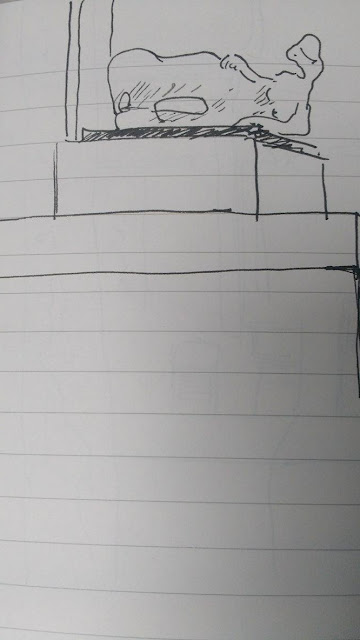The paradox of play: Real fun should be terrifying
It has taken me quite a while to get my head around the messages contained in this article, which, although being written by Douglas Heaven, focuses primarily on the book- "Play Anything: The pleasure of limits, the uses of boredom, and the secret of games" by Ian Bogost. I had to do some more reading around Bogost's book before I felt I had a clear grasp on it's content, as the article is quite meandering and speculative. I decided the predominant idea in the book,although I am being a little reductive, is that fun is created through the satisfaction of overcoming obstacles and operating effectively within practical restraints. It's a fairly broad, abstract concept, and one which I certainly struggled with in terms of how i might illustrate it.I decided, in the end, not worry too much about trying to capture the whole article in an image and instead opted for a more simplistic approach, taking small portions of the article which I thought might make nice images in themselves. I decided I could create stronger images if the ideas behind them were simplified, and that often it is not essential for editorial illustrations to encapsulate everything in an article, they can simply provide some kind of visual engagement which might draw a person in to reading it.
The first two (incidentally my favourite) ideas are taken from a direct quote from Bogost's book, and an anecdote from it described in the article:
"A spoonful of sugar may help the medicine go down, but Mary Poppins' song was a sham."
This inspired my idea of a drawing depicting a sinister Mary Poppins force feeding a spoonful of sugar into a child's mouth, and i began playing around with that idea.
I think I'll leave the boy unfilled and draw Mary Poppins in a grey wash as an attempt to make the image clearer. I also think I'll experiment with composition a little to make Mary Poppins tower over the boy more seeing as I intend to accommodate this image within a 200mm by 105mm space.
E.G.
I also need to experiment with different ways of drawing the spoon to make sure the image is clear because in a lot of my roughs it's quite difficult to distinguish what's happening.
My second idea is a little more straight forward, concerning Bogost's recollection of "rushing" his young daughter through a crowd, "dragging her by the hand. She should have been miserable, but she used his pull across the tiled floor as a new constraint that made her don't-step-on-the-cracks game more fun that usual." I really like this image and decided it could make an effective and relevant illustration in itself.
I originally thought that this, too, would work best in the portrait framing but have since decided that it actually fits quite nicely into the 290mm by 105mm space. I also had a lot of trouble thinking up ideas which would work in those dimensions so I was very pleased when I discovered that one of my favourites worked so well in them.

I'm pretty happy with this last rough and feel like I can confidently start my final version, although I reckon I'll draw it twice as large and photocopy it down to the correct dimensions.
In both of these ideas I am currently working under the impression that the respective children be rendered in clear white and line, whilst the other characters etc will appear in a grey wash. This can serve as a way of increasing the level of menace and darkness in my depiction of Mary Poppins, and isolating the energetic 'fun' little girl against the dull blur of adulthood in my second illustration.
I have toyed with the idea of using a colour to pick out significant elements in each but need to experiment with that before deciding if and how I would go about doing that. I have been sticking to analogue media, mostly dipping pen/ brush and ink, because I have a relatively short time to finish the brief, I enjoy working in this media a lot, and because I find it to be very expressive which i feel is essential to my ideas as they are more visually based than conceptually based.
My final idea evolved from the notion of using children's toys and depicting adults playing with children's toys, to the more simple and more effective concept of depicting models in the style of children's toy soldiers (E.G the picture below) carrying out everyday, boring activities.
Although I am happy with this as a concept, it needs the most work out of the three to become fully realised. I have played around with composition (within the square 200mm by 200mm format that it will be drawn in) a little and have found it very difficult to come up with one that creates a strong image. I have decided that the image is improved with the inclusion of a context/ physical space but still need to explore options within that.
My other slight issue with this idea is, if i hypothetically use colour in these images, which element of this drawing would I use it on. There is no obvious part of the drawing that is more significant, and so that is also something I'll have to think about.







































































